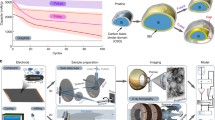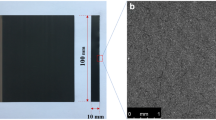Abstract
Crystallographic structural changes in a commercial 5 Ah prismatic graphite–NMC battery were investigated during its operation using energy-dispersive X-ray diffraction. The characteristic diffraction peaks for the anode and cathode were identified, and their peak positions were linked to the charge–discharge cycle of the battery. The edge of the negative terminal of battery was shown to undergo irregular cycling behavior. Stresses developed at the battery layer interfaces were proposed to be the source for this deterioration, which limits the lifetime of the battery. The effect of pulse discharge on strain in cathode has also been studied.










Similar content being viewed by others
References
Kempener R, Borden E (2015) Battery storage for renewables: market status and technology outlook. IRENA International Energy Storage Policy and Regulation, Abu Dhabi
Sakti A, Michalek JJ, Fuchs ER, Whitacre JF (2015) A techno-economic analysis and optimization of Li-ion batteries for light-duty passenger vehicle electrification. J Power Sources 273:966–980
Chiang Y-M (2010) Building a better battery. Science 330:1485–1486
Doeff MM, Brodd RJ (2013) Battery cathode, in batteries for sustainability: selected entries from the encyclopedia. R.A. Meyers, New York
Fu K, Gong Y, Liu B et al (2017) Toward garnet electrolyte–based Li metal batteries: an ultrathin, highly effective, artificial solid-state electrolyte/metallic Li interface. Sci Adv 3(4):e1601659
Han X, Gong Y, Fu K et al (2017) Negating interfacial impedance in garnet-based solid-state Li metal batteries. Nat Mater 16(5):572–579
Tarascon JM, Armand M (2010) Issues and challenges facing rechargeable lithium batteries. In: Dusastre V (ed) Materials for sustainable energy. Co-Published with Macmillan Publishers Ltd, London, pp 171–179
Buchberger I, Seidlmayer S, Pokharel A, Piana M, Hattendoff J, Kudejova P, Gilles R, Gasteiger HA (2015) Aging analysis of graphite/LiNi1/3Mn1/3Co1/3O2 cells using XRD, PGAA, and AC impedance. J Electrochem Soc 162(14):A2737–A2746
Vetter J (2005) Ageing mechanisms in lithium-ion batteries. J Power Sources 147(1):269–281
Newman J (1995) Optimization of porosity and thickness of a battery electrode by means of a reaction-zone model. J Electrochem Soc 142(1):97–101
Padhi AK, Nanjundaswamy KS, Goodenough JB (1997) Phospho-olivines as positive-electrode materials for rechargeable lithium batteries. J Electrochem Soc 144(4):1188–1194
Albertini VR, Perfetti P, Ronci F, Reale P, Scrosati B (2001) In situ studies of electrodic materials in Li-ion cells upon cycling performed by very-high-energy X-ray diffraction. Appl Phys Lett 79(1):27–29
Glazer MPB, Okasinski JS, Almer JD, Ren Y (2016) High-energy X-ray scattering studies of battery materials. MRS Bull 41(06):460–465
Iizumi M (1986) Real-time neutron diffraction studies of phase transition kinetics. Physica B + C 136(1):36–41
Lin F, Liu Y, Yu X et al (2017) Synchrotron X-ray analytical techniques for studying materials electrochemistry in rechargeable batteries. Chem Rev 117(21):13123–13186
Taminato S, Yonemura M, Shiotani S et al (2016) Real-time observations of lithium battery reactions-operando neutron diffraction analysis during practical operation. Sci Rep 6:28843
Trucano PC, Chen R (1975) Structure of graphite by neutron diffraction. Nature 258:136–137
Yin SC, Rho YH, Swainson I, Nazar LF (2006) X-ray/neutron diffraction and electrochemical studies of lithium De/Re-Intercalation in Li1−xCo1/3Ni1/3Mn1/3O2 (x = 0 → 1). Chem Mater 18(7):1901–1910
Allen MG, Mehregany M, Howe RT, Senturi SD (1987) Microfabricated structures for the in situ measurement of residual stress, Young’s modulus, and ultimate strain of thin films. Appl Phys Lett 51(4):241–243
Covey-Crump SJ, Schofiled PF, Stretton IC, Daymond MR, Kight KS, Tant J (2013) Monitoring in situ stress/strain behaviour during plastic yielding in polymineralic rocks using neutron diffraction. J Struct Geol 47:36–51
Croft M, Zhong Z, Jiswawi N, Zakharchenko I, Holtz RL, Skaritka J, Fast T, Sadananda K, Lakshmipathy M, Tsakalakos T (2005) Strain profiling of fatigue crack overload effects using energy dispersive X-ray diffraction. Int J Fatigue 27(10):1408–1419
Daymond MR, Bourke MAM, Von Dreele RB, Clausen B, Lorentzen T (1997) Use of Rietveld refinement for elastic macrostrain determination and for evaluation of plastic strain history from diffraction spectra. J Appl Phys 82(4):1554–1562
Paxton WA, Akdoğan EK, Şavkliyildiz I, Chokshi AU, Silver SX, Tsakalakos T, Zhong Z (2014) Asynchronous stoichiometric response in lithium iron phosphate batteries. J Mater Res 30(3):417–423
Paxton WA, Zhong Z, Tsakalakos T (2015) Tracking inhomogeneity in high-capacity lithium iron phosphate batteries. J Power Sources 275:429–434
Billaud D, Henry FX, Lelaurian M, Wilmann P (1996) Revisited structures of dense and dilute stage II lithium-graphite intercalation compounds. J Phys Chem Solids 57(6):775–781
Park JS, Okasinski J, Chatterjee K, Chen Y, Almer J (2017) Non-destructive characterization of engineering materials using high-energy X-rays at the advanced photon source. Synchrotron Radiat News 30(3):9–16
Wang XL, An K, Cai L et al (2012) Visualizing the chemistry and structure dynamics in lithium-ion batteries by in situ neutron diffraction. Sci Rep 2:747
Dahn JR, Fong R, Spoon MJ (1990) Suppression of staging in lithium-intercalated carbon by disorder in the host. Phys Rev B 42(10):6424–6432
Majid N, Hafiz S, Arianto S et al (2016) Analysis of effective pulse current charging method for lithium ion battery. J Phys Conf Ser 817:012008
Guerard D, Herold A (1975) Intercalation of lithium into graphite and other carbons. Carbon 13(4):337–345
Ogumi Z, Inaba M (1998) electrochemical lithium intercalation within carbonaceous materials: intercalcation process, surface film formation, and lithium diffusion. Bull Chem Soc Jpn 71(14):521–534
Dolotko O, Senyshyn A, Muhlbauer MJ, Nikolowski K, Ehrenberg H (2014) Understanding structural changes in NMC Li-ion cells by in situ neutron diffraction. J Power Sources 255:197–203
Gu YJ, Chen YB, Liu HQ, Wang YM, Wang CL, Wu HK (2011) Structural characterization of layered LiNi0.85−xMnxCo0.15O2 with x = 0, 0.1, 0.2 and 0.4 oxide electrodes for Li batteries. J Alloys Compd 509(30):7915–7921
Kim JM, Chung HT (2004) The first cycle characteristics of Li[Ni1/3Co1/3Mn1/3]O2 charged up to 4.7 V. Electrochim Acta 49(6):937–944
Momma K, Izumi F (2011) VESTA 3 for three-dimensional visualization of crystal, volumetric and morphology data. J Appl Crystallogr 44(6):1272–1276
Liao PY, Duh JG, Lee JF, Sheu HS (2007) Structural investigation of Li1−xNi0.5Co0.25Mn0.25O2 by in situ XAS and XRD measurements. Electrochim Acta 53(4):1850–1857
Mohanty D, Sefat AS, Kalnaus S, Li J, Meisner RA, Payzant EA, Abraham DP, Wood DL, Daniel C (2013) Investigating phase transformation in the Li1.2Co0.1Mn0.55Ni0.15O2 lithium-ion battery cathode during high-voltage hold (4.5 V) via magnetic, X-ray diffraction and electron microscopy studies. J Mater Chem A 1(20):6249–6261
Christopher Arcus, Lithium Batteries—Clues To The Mystery. https://cleantechnica.com/files/2018/02/battery-cell-shapes.jpg. Accessed 6 Sept 2018
Hooper A, Powell RJ, Marshall TJ, Neat RJ (1989) Pulse discharge characteristics of solid-state lithium batteries. J Power Sources 27(1):3–13
Leng F, Tan CM, Pecht M (2015) Effect of temperature on the aging rate of Li ion battery operating above room temperature. Sci Rep 5:12967
Acknowledgements
The authors wish to express their gratitude for the financial support provided by the Office of Naval Research (ONR) and Dr. Antti Makineen under Contract No. N00014-15-1-2492. This research used resources of the Advanced Photon Source, a U.S. Department of Energy (DOE) Office of Science User Facility operated for the DOE Office of Science by Argonne National Laboratory under Contract No. DE-AC02-06CH11357.
Author information
Authors and Affiliations
Corresponding author
Ethics declarations
Conflict of interest
All authors declare that they have no conflict of interest.
Rights and permissions
About this article
Cite this article
Jha, S.K., Charalambous, H., Okasinski, J.S. et al. Using in operando diffraction to relate lattice strain with degradation mechanism in a NMC battery. J Mater Sci 54, 2358–2370 (2019). https://doi.org/10.1007/s10853-018-3007-8
Received:
Accepted:
Published:
Issue Date:
DOI: https://doi.org/10.1007/s10853-018-3007-8




